Alex Itin has posted a new “print” of his mind-blowing Moby-Dick animation, “Orson Whales,” on Vimeo, which now offers gorgeous high definition streaming. Click the image below.
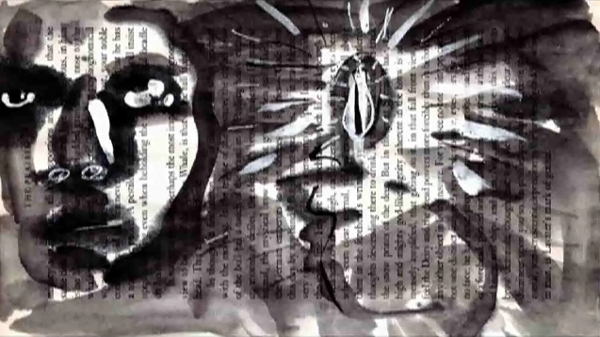
Category Archives: melville
textual montage: the documentary biography
There’s something about the work of Herman Melville that brings out the unexpected in his readers. Example can be drawn almost at random. Call Me Ishmael, the poet Charles Olson’s lyrical little book on Moby-Dick, is as much a meditation on patrimony, artistic and otherwise, as it is about Melville. When the U. S. government locked him up at Ellis Island, the Trinidadian socialist C. L. R. James took the opportunity to move into literary criticism, writing Mariners, Renegades and Castaways: The Story of Herman Melville and the World We Live In, in which he found Melville a sympathetic audience for his argument against state capitalism. Maurice Sendak, best known for Where the Wild Things Are, created semi-pornographic illustrations for an edition of Pierre, Melville’s little-known novel about incest and doubt. Claire Denis turned the comparatively staid Billy Budd into Beau Travail, a sun-dazed film about the French Foreign Legion that culminates in one of the most desparate dance numbers ever. Paul Metcalf, Melville’s great-grandson, smashed together Columbus, teratology, the Bobby Greenlease kidnapping & murder of 1953, and his family’s misgivings about their ancestor to form Genoa, a collage novel.
I set off to write about Metcalf and his unclassifiable books – most of them textual collages made of appropriated writing. Metcalf’s writing is perhaps worth paying attention to in light of electronic media, thoughhere’s precious little about him on the Internet (an interview, an obituary). Thinking about Metcalf’s work, however, I found myself sidetracked: when asked about the inspirations for his textual collages, he pointed to another work on Melville, Jay Leyda’s The Melville Log. I’ll return to Metcalf some other time; he’s not going anywhere.
The Melville Log, though. This is a book that might be just as weird as anything else that Melville ever inspired. It’s also instructive for thinking about how composition in the age of the ubiquitous archive could work. First, a bit of backstory: though Melville was prominent early in his career, he’d faded entirely from the American consciousness by 1920, when Billy Budd was discovered and Moby-Dick was discovered to be the Great American Novel of the nineteenth century. Literary scholars went to work scrutinizing Melville’s life and work; Jay Leyda arrived on the scene in the 1940s, having missed the main boom, but being a big part of a post-war boomlet. In 1951, after years of work, he published The Melville Log, a compilation of first-hand sources about Melville’s life and work. In the half-century since, it’s become a foundational text for anyone seeking to learn about Melville’s life.
I knew that much – just about anyone who’s read Melville has heard of The Melville Log – but I’d never bothered to actually look at a copy of Leyda’s book. From that description, it doesn’t sound interesting. But I found a cheap used copy on Amazon & ordered it; a week later, it turned up on my door. From the dedication, it became clear that this wasn’t the book I’d assumed it was:
This book was begun as a birthday present
for my teacher, Sergei Eisenstein.
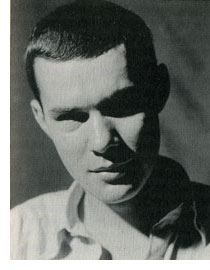 Jay Leyda, it turns out, wasn’t just a literary historian; in fact, he’s best known as a film historian, a field in which he played a foundational role. He had, it seems clear, an interesting life. Considering an career as a filmmaker, Leyda went to Moscow in the 1930s to study film with Eisenstein, the only American to do so; he seems to have worked on Bezhin Meadow as a stills photographer. Returning to the U.S., he served as an advisor to Mission to Moscow, a propaganda film designed to shore up American support for the Soviet Union during WWII (a film later to be soundly denounced as evidence of Hollywood’s un-Americanism). From there he went on to write his Melville book; he also wrote biographies of Emily Dickinson, Sergei Rachmaninoff, and Modest Mussorgsky, as well as a substantial amount of film criticism on Soviet and Chinese films.
Jay Leyda, it turns out, wasn’t just a literary historian; in fact, he’s best known as a film historian, a field in which he played a foundational role. He had, it seems clear, an interesting life. Considering an career as a filmmaker, Leyda went to Moscow in the 1930s to study film with Eisenstein, the only American to do so; he seems to have worked on Bezhin Meadow as a stills photographer. Returning to the U.S., he served as an advisor to Mission to Moscow, a propaganda film designed to shore up American support for the Soviet Union during WWII (a film later to be soundly denounced as evidence of Hollywood’s un-Americanism). From there he went on to write his Melville book; he also wrote biographies of Emily Dickinson, Sergei Rachmaninoff, and Modest Mussorgsky, as well as a substantial amount of film criticism on Soviet and Chinese films.
What’s the importance of this to his book on Melville? If Leyda learned anything from Eisenstein, it was the value of montage, putting adjacent shots into juxtaposition to create new meaning. Leyda explained what he was doing in his introduction:
The result is a book made of documents, documents of many kinds and from many sources, written by many men and women (and some children); but documents cannot be accepted unconditionally. A ‘document’ should be distrusted as much as a photograph, for documents are a fallible as their human authors. Letters contained as many falsehoods and misunderstandings in 1851 as they do in 1951, and journalists and critics (and typesetters) of a century ago operated under much the same pressures that they do today. Each document quoted here requires some judgment of its author’s motives and character – although perhaps the First Mates who kept the whaling logs may be thought beyond suspicion.
(p. xii.) A few scanned spreads from the book give a feeling for its contents, how it juxtaposes bits and pieces of letters, business documents, journals, and Melville’s work, using time – the march of years from Melville’s birth to his death – as its central axis. Essentially, it’s Eisenstein’s montage, moved from the world of film into that of books, with not a little of what would subsequently be called multimedia. Click to enlarge:
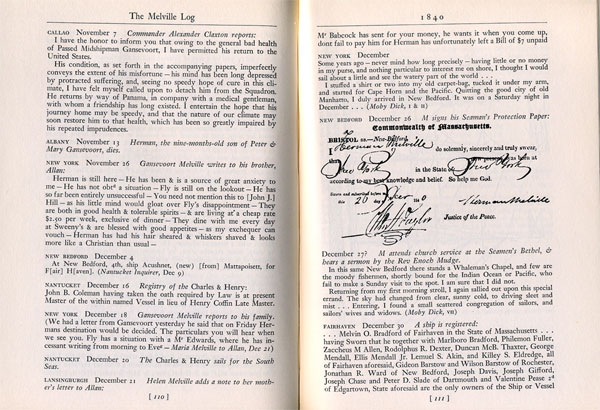
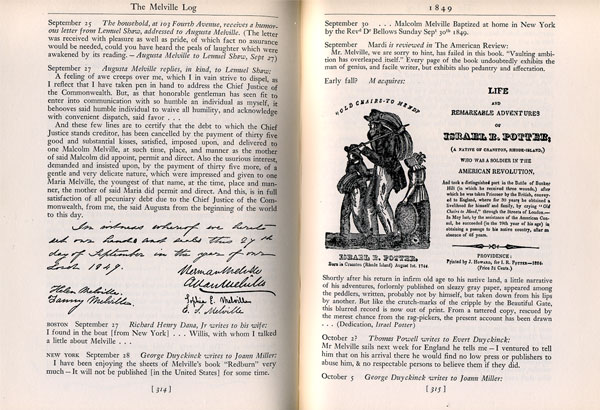
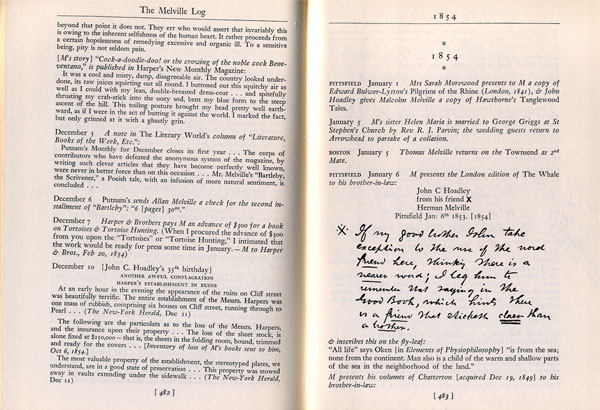
For a book that might be thought of as a biography, there seems to be very little of the biographer: only the unobtrusive introduction to each entry is in Leyda’s hand. (Tucked away at the back of the book, of course, is an enormous list of the sources of quotation.) But lack of the author’s words doesn’t signify the author’s lack of intention. Here’s Eisenstein explaining montage in Film Form, translated by Leyda: “By combining these monstrous incongruities we newly collect the disintegrated event into one whole, but in our aspect.” Leyda, in his own introduction, winks at this: clearly, he’s one of “the First Mates who kept the whaling logs” who would wish to be thought beyond suspicion.
There’s a very interesting reading of Leyda’s collage-work – and the way collage works – in Clare L. Spark‘s Hunting Captain Ahab: Psychological Warfare and the Melville Revival, a thorough dissection of the forces that made Melville into the Melville we think we understand. Melville’s life is a challenge for the prospective biographer: there’s not the usual plot arc or easy moral to be drawn from it, though that hasn’t stopped people from trying to do so: a Great American Novelist needs to behave properly. According to Spark:
Leyda arranged his chronology of Melville’s hitherto confusing or mysterious life to track a progression from Ahab’s family-splitting bourgeois individualism to Billy Budd’s socially responsible sacrifice on behalf of family unity and order, ordering Melville in the process. Every detail of The Melville Log was designed to fortify that message.
(pp. 10–11.) Spark has harsher words for Leyda in her chapter on his work: she sees him as a dyed-in-the-wool Stalinist and details the ways in which suppresses and misrepresents information in the guise of presenting the unvarnished truth. If you’re interested in Melville or twentieth-century American propaganda – from both the right and the left – hers is a fascinating book and well worth seeking out.
* * * * *
But let’s return from the depths of Melville criticism. If, as Spark argues, The Melville Log presents a subjective view of Melville to his readers, it’s only able to do so because Leyda knew that only a miniscule fraction of those who read his book would be able or have the inclination to consult the original documents that he was quoting, the majority of which weren’t publicly accessible.
A thought experiment: what happens if, thanks to book-scanning projects, all those sources were publicly accessible?(The University of Connecticut’s Olson collection might be seen as a start.) Having everything available doesn’t obviate the need for projects like Leyda’s; we need editors to sort through the chaff and to point out the things that are interesting. A born-digital project like this could be instantly accountable in a way that it would be difficult for a print version to be: a link could take the reader from the quotation to the quoted document. Going further: a reader who’s dissatisfied with the slant of a digital Melville Log could assemble their own alternate version.
Technically, this isn’t difficult. But the tools to do this don’t seem to exist yet; and supporting this sort of ecosystem of research doesn’t seem to be an immediate priority for those compiling archives.
eeeeeeeeeee…..eeeeeeee…eeeee

Moby Dick Chapter 55 or 9200 times E”, 2004, graphite on hemp paper, 11 x 9″
In one of those odd, blogospheric delayed reactions, I just came across (via Information Aesthetics, via Kottke) a fabulous exhibit that took place this past March by an artist named Justin Quinn, who does beautiful, mysterious work with text. Quinn’s Moby-Dick series is made up of obsessively detailed prints and graphite drawings composed entirely of the letter E. Each E corresponds to a letter in a chapter of Melville’s book, so each piece is composed of literally thousands of characters. The effect is almost that of a mosaic or a concrete poem. This series was shown at MMGalleries in San Francisco and has since moved elsewhere (Miami possibly?), but there are still a number of images online (also here). Quinn explains his obsession with E:
The distance between reading and seeing has been an ongoing interest for me. Since 1998 I have been exploring this space through the use of letterforms, and have used the letter E as my primary starting point for the last two years. Since E is often found at the top of vision charts, I questioned what I saw as a familiar hierarchy. Was this letter more important than other letters? E is, after all, the most commonly used letter in the English language, it denotes a natural number (2.71828), and has a visual presence that interests me greatly. In my research E has become a surrogate for all letters in the alphabet. It now replaces the other letters and becomes a universal letter (or Letter), and a string of Es now becomes a generic language (or Language). This substitution denies written words their use as legible signifiers, allowing language to become a vacant parallel Language -? a basis for visual manufacture.
After months of compiling Es into abstract compositions through various systemic arrangements, I started recognizing my studio time as a quasi-monastic experience. There was something sublime about both the compositions that I was making and the solitude in which they were made. It was as if I were translating some great text like a subliterate medieval scribe would have years ago – ?with no direct understanding of the source material. The next logical step was to find a source. Herman Melville’s novel Moby Dick, a story rich in theology, philosophy, and psychosis provides me with a roadmap for my work, but also with a series of underlying narratives. My drawings, prints, and collages continue to speak of language and the transferal of information, but now as a conduit to Melville’s sublime narratives.
Gazing at these for a while (digital reproductions of course… and on my browser… and brought to my attention through technology blogs), I couldn’t help but start to draw some connections between Quinn’s work and computers. There’s plenty of digital artwork and visualization programs that render text into complex visual formations, sometimes with the intention of discovering new meanings and relationships, other times purely to play with form. Every now and then, someone manages to achieve both. This is a detail from Brad Paley’s rendering of Gamer Theory through his program Text Arc:
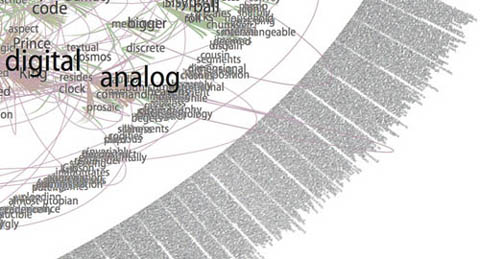
Others can be beautiful to handle, but are ultimately opaque, like Ben Fry’s “Valence”:

These two images are from another work submitted to our Gamer Theory visualization gallery, a map of nouns and verbs in Wark’s text (first is full, second is a detail). It’s pretty, but basically meaningless.

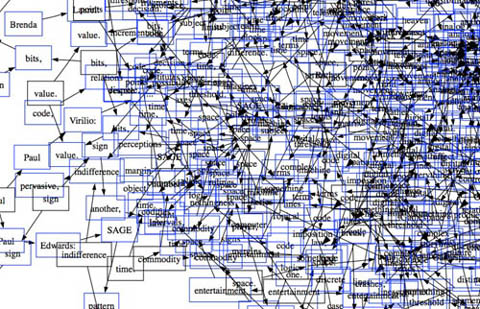
Quinn’s work is also difficult to penetrate, but something about it holds my attention. I’m not sure how aware Quinn is of the digital work being done today, but viewing his pieces against the contemporary technological backdrop, and his own self-described feeling of being the “subliterate medieval scribe” as he makes his minute articulations, my mind runs off in a number of directions. Seeing that his work is in a way “pixelated” – ?his Es a “basis for visual manufacture” – ?I imagine him as a sort of human computer – ?a monastic machine – ?processing (or intuiting) the text by infintessimal degrees through his own inner algorithm.
After all, a computer’s work is “subliterate.” Algorithms must be designed with intelligence, but the actual running of the program is physical, mindless. Viewed this way, Quinn’s work is like a dive into the mania of operations usually carried out with blazing speed by microprocessors. This is not to diminish it, or to call it cold and mechanical. Rather I’m pondering whether there is perhaps a spiritual dimension to the repetitive, sub-rational activities of our machines, which, if transposed to human scale, can become a sort of devotional exercise, like the routines of Buddhist monks, endlessly painting and carving Chinese characters in order to empty their minds (other links between monks and computers here and here).
What’s particularly evocative to me about the work, however, is how it treads the line between that meditative quality and the obsessive. There is something frightening about them (or about any kind of fanatically detailed artwork, or about computers for that matter), like the reams of psychotic babble typed out ceaselessly by Jack Nicholson in “The Shining.” Or is it Ahab’s vengeance algorithm we’re seeing, running on overdrive until the machine (or ship) crashes?
In the end, Quinn’s images are mysterious, his algorithm inscrutable, although my mind immediately goes to work trying to link up Melville’s themes and images to those endless strings of Es.
Here’s that first image again with a quote from the source text that seemed to me to connect. Chapter 55, “Of the Monstrous Pictures of Whales”:

Moby Dick Chapter 55 or 9200 times E”, 2004, graphite on hemp paper, 11 x 9″
But these manifold mistakes in depicting the whale are not so very surprising after all. Consider! Most of the scientific drawings have been taken from the stranded fish; and these are about as correct as a drawing of a wrecked ship, with broken back, would correctly represent the noble animal itself in all its undashed pride of hull and spars. Though elephants have stood for their full-lengths, the living Leviathan has never yet fairly floated himself for his portrait. The living whale, in his full majesty and significance, is only to be seen at sea in unfathomable waters; and afloat the vast bulk of him is out of sight, like a launched line-of-battle ship; and out of that element it is a thing eternally impossible for mortal man to hoist him bodily into the air, so as to preserve all his mighty swells and undulations.
This one is of chapter 71, “The Jeroboam’s Story” (I spoke briefly on the phone with one of the curators who told me that Quinn had explained this as an inverted halo, reflecting the anti-Christ-like character described in the chapter – ?I almost see an aerial view of a whale cutting through water):

Moby Dick Chapter 71 or 9,814 times E”, 2006, mixed media, 11 x 15″
…but straightway upon the ship’s getting out of sight of land, his insanity broke out in a freshet. He announced himself as the archangel Gabriel, and commanded the captain to jump overboard. He published his manifesto, whereby he set himself forth as the deliverer of the isles of the sea and vicar-general of all Oceanica. The unflinching earnestness with which he declared these things; – the dark, daring play of his sleepless, excited imagination, and all the preternatural terrors of real delirium, united to invest this Gabriel in the minds of the majority of the ignorant crew, with an atmosphere of sacredness. Moreover, they were afraid of him. As such a man, however, was not of much practical use in the ship, especially as he refused to work except when he pleased, the incredulous captain would fain have been rid of him; but apprised that that individual’s intention was to land him in the first convenient port, the archangel forthwith opened all his seals and vials – devoting the ship and all hands to unconditional perdition, in case this intention was carried out. So strongly did he work upon his disciples among the crew, that at last in a body they went to the captain and told him if Gabriel was sent from the ship, not a man of them would remain.
moby-dick animated
Alex Itin has done it again. Here it is: “Orson Whales,” an intertextual fantasia on Moby-Dick and Orson Welles set to the savage drums of John Bonham. Each frame is a page of this edition of the Melville text, painted and photographed and strung together in iMovie.
What you’re seeing is the entire book (actually two full copies – Alex can only paint on one side of each page because of bleed-through, so to get the whole text he had to double up). Here’s some of it stacked up in the studio (this is months of work):

The soundtrack is detritus gathered from web searches, a hunt for the white whale through a sea of tangents – appropriate, really, for the great book, which is so notoriously (and gloriously) tangential.
Alex: “The soundtrack is built from searching “moby dick” on You Tube (I was looking for Orson’s Preacher from the Huston film from the fifties) I couldn’t find the preacher, but did find tons of Led Zep and drummers doing Bonzo and a little Orson……. makes for a nice Melville in the end.”
Also check out his animation, same technique, of Ulysses. Bravo, Alex! (and happy birthday)!
google makes slight improvements to book search interface
Google has added a few interface niceties to its Book Search book viewer. It now loads multiple pages at a time, giving readers the option of either scrolling down or paging through left to right. There’s also a full screen reading mode and a “more about this book” link taking you to a profile page with links to related titles plus references and citations from other books or from articles in Google Scholar. Also on the profile page is a searchable keyword cluster of high-incidence names or terms from the text.
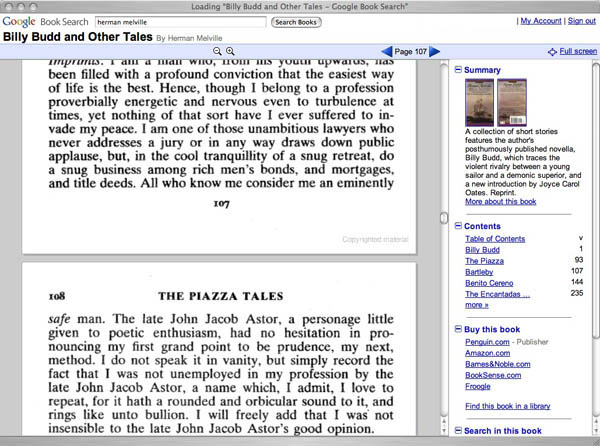
Above is the in-copyright Signet Classic edition of Billy Budd and Other Tales by Melville, which contains only a limited preview of the text. You can also view the entire original 1856 edition of Piazza Tales as scanned from the Stanford Library. Public domain editions like this one can now be viewed with facing pages.
Still a conspicuous lack of any annotation or social reading tools.

